Understanding the Reasons Behind the Fights
Understanding why dogs fight in the first place is an important first step in preventing such occurrences. It’s crucial to remember that dogs are pack animals by nature. This means they instinctively form hierarchical relationships within their social groups. Disputes often arise when there’s a challenge to the established order.
Here are some common reasons why dogs might fight:
- Dominance disputes
- Territorial disputes
- Fear
- Excitement or overstimulation
Recognizing Warning Signs
Prevention is the best way to handle dog fights. By learning to recognize the warning signs, you can often intervene before a situation escalates into a fight.
Some signs to look out for include:
- Raised hackles
- Stiff body posture
- Direct eye contact between dogs
- Growling or snarling
- Lip licking or yawning
How to Prevent Dog Fights
Preventing dog fights requires ongoing effort. Below are some steps you can take:
- Socialization: Socialize your dogs from a young age and ensure they regularly interact with other dogs in a controlled environment.
- Training: Teach your dogs basic commands like sit, stay, and leave.
- Supervision: Always supervise your dogs when they’re interacting with each other, especially if they have a history of fighting.
- Separation: If you notice signs of tension, separate your dogs until they’ve calmed down.
How to Break Up a Dog Fight Safely
If a fight does break out, it’s vital to know how to intervene safely. Remember, your safety is paramount.
Here’s a step-by-step guide:
- Create a loud noise to distract the dogs.
- Use a barrier to separate them.
- Once separated, keep them apart until they’ve both calmed down.
After the Fight: Healing and Reconciliation
After a fight, it’s essential to give each dog some time to calm down. They should be kept separate during this time.
Consider seeking professional help if fights continue to occur. This could be in the form of a dog behaviorist or dog trainer.
| Steps After a Fight | Description |
|---|---|
| Step 1: Cool down period | Allow each dog to calm down separately |
| Step 2: Check for injuries | Carefully check each dog for injuries |
| Step 3: Reintroduction | Slowly reintroduce the dogs in a neutral space |
| Step 4: Seek professional help | If fights continue, consider seeking the help of a professional |
Frequently Asked Questions
Q: Can I physically separate my dogs if they’re fighting?
A: It’s generally not advisable as you risk getting injured. Use a barrier or distraction instead.
Q: Should I punish my dogs if they fight?
A: Punishing dogs after a fight can create more fear and anxiety, potentially increasing the risk of future fights. Focus on positive reinforcement instead.
Q: When should I seek professional help?
A: If fights continue to occur despite your efforts, or if fights are resulting in serious injuries, seek professional help.



